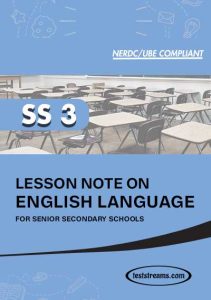This Lesson Note on ENGLISH for SS3 Note was pulled from our book (
LESSON NOTE ); Compiled to serve as reference material to help teachers draw out their lesson plan easier, saving you valuable time to focus on the core job of teaching.
The Lesson notes are based on the current NERDC curriculum (UBE compliant)
This Free Lesson Note on ENGLISH for SS3 Lesson Note Covers The Following Topics
- VOCABULARY DEVELOPMENT IN CULTURE
- ORAL INTONATION PATTERN- RISING AND FALLING TONE IN STATEMENTS
- READING COMPREHENSION
- ORAL CONSONANT CLUSTERS
- CONJUNCTIONS
- THE SCHWA AS FINAL UNSTRESSED SYLLABLE
- ENGAGING IN MEANINGFUL DIALOGUE ON ANY GIVEN SUBJECT MATTER
- ARGUMENTATIVE TOPICS, COMPLEX SENTENCE STRUCTURES AND SUMMARIZING TIPS
- DIFFERENTIATION BETWEEN BRITISH AND AMERICAN SPELLINGS OF COMMON WORDS
WEEK1
English Language SS 3, First Term
What is Vocabulary Development?
Vocabulary Development can be defined as the process through which human beings acquire words right from infancy. This process typically starts with the babbling of sounds which is associated with babies. Over time, this shifts towards meaningful speech patterns as the babies grow. And by age one, most babies are able to produce their first words. Meanwhile, as you may well know, most infants used their early formative years to build to build up their vocabularies. This is always a gradual and even slow process.
Further Explanation: Vocabulary Development in Culture
In order to build their vocabularies, infants begin by learning about the meanings associated with words. This is referred to as mapping problem, which is all about how infants are able to correctly attach words to referents. They learn this by mere practice- communicating with family members who teach them how to relate with society, and with friends too. As a matter of fact, friends have been noted as playing very vital roles in the vocabulary formation process. This is because in their interactions with peers, children have the opportunity to learn about unique conversational roles.
Phonological Development
Studies related to vocabulary development show that children’s language competence depends upon their ability to hear sounds during infancy. Infants’ perception of speech is distinct. Between six and ten months of age, infants can discriminate sounds used in the languages of the world. By 10 to 12 months, infants can no longer discriminate between speech sounds that are not used in the language(s) to which they are exposed. Among six-month-old infants, seen articulations (i.e. the mouth movements they observe others make while talking) actually enhance their ability to discriminate sounds, and may also contribute to infants’ ability to learn phonemic boundaries. Infants’ phonological register is completed between the ages of 18 months and 7 years.
Children’s phonological development normally proceeds as follows:
6–8 weeks: Cooing appears
16 weeks: Laughter and vocal play appear
6–9 months: Reduplicated (canonical) babbling appears
12 months: First words use a limited sound repertoire
18 months: Phonological processes (deformations of target sounds) become systematic
18 months–7 years: Phonological inventory completion
At each stage mentioned above, children play with sounds and learn methods to help them learn words. There is a relationship between children’s pre-linguistic phonetic skills and their lexical progress at age two: failure to develop the required phonetic skills in their pre-linguistic period results in children’s delay in producing words.Environmental influences may affect children’s phonological development, such as hearing loss as a result of ear infections. Deaf infants and children with hearing problems due to infections are usually delayed in the beginning of vocal babbling.
It is important to note that vocabulary development in every culture is inevitable as it is necessary for every child’s learning process. Most times, this process occurs naturally while on a few occasions some children may experience difficulties due to certain impairments in their motor skills. In any case, assistance from parents and caregivers go along way in speeding up and helping children to acquire the needful vocabulary and begin the learning process which life is all about. And the interesting thing is that this vocabulary development process never really stops throughout anybody’s lifetime as we all keep learning/acquiring new words within our specific cultures until the day we die.
Comprehension: Listening Rudiments on Comprehension to Produce main Points and Ideas in Speeches, Lectures or Discussions
| Listening comprehension is the receptive skill needed to decode information in the oral mode. In other words, it has to do with the ability to understand what is being spoken to you. Unfortunately, as simple as these sounds, not many people are able to effectively listen to understand. This is a serious problem in the communication process that is often over-looked if not disregarded as a non-factor. However, in order to be an effective communicator, it is imperative that that you acquire the right listening skills and use them every time you are engaged in any form of verbal communication with people. Enumerated below are some of the rudiments to effective verbal comprehension. |
1: Face the Speaker and Maintain Eye Contact: Do your conversational partners the courtesy of turning to face them. Put aside papers, books, the phone and other distractions. Look at them, even if they don’t look at you.
2: Be attentive, but relaxed: Now that you’ve made eye contact with the speaker, you have to stay relaxed and yet focused. In other words, you don’t have to stare consistently at the other speaker throughout the duration of his or her speech. You can look away now and then and carry on like a normal person. The important thing is to be attentive. The dictionary says that to “attend” another person means to:
- be present
- give attention
- apply or direct yourself
- pay attention
- remain ready to serve
3: Keep an open mind: Listen without judging the other person or mentally criticizing the things she tells you. If what she says alarms you, go ahead and feel alarmed, but don’t say to yourself, “Well, that was a stupid move.” As soon as you indulge in judgmental bemusements, you’ve compromised your effectiveness as a listener.
4: Listen to the words and try to picture what the speaker is saying: Allow your mind to create a mental model of the information being communicated. Whether a literal picture, or an arrangement of abstract concepts, your brain will do the necessary work if you stay focused, with senses fully alert. When listening for long stretches, concentrate on, and remember, key words and phrases.
6: Wait for the speaker to pause to ask clarifying questions: When you don’t understand something, of course you should ask the speaker to explain it to you. But rather than interrupt, wait until the speaker pauses. Then say something like, “Back up a second. I didn’t understand what you just said about…”
Summary Writing
A summary is a record in a reader’s own words that gives the main points of a piece of writing such as a newspaper article, the chapter of a book, or even a whole book. It is also possible to summarize something that you have heard, such as a lecture, or something that you have seen and heard, such as a movie. A summary omits details, and does not include the reader’s interpretation of the original.
Important things to note about summary writing-
- As you read, underline all the important points and and all the important evidence. For example, you could look for all the topic sentences. Words that are repeated several times are likely to be keywords. Transition words can help understanding of the overall structure of a passage.2. List or cluster the main idea of the whole piece, the main supporting ideas, and the main evidence for each idea. Use of the same keywords or technical expressions is probably unavoidable. However, be careful to express the ideas in your own way, using your own vocabulary and expressions as much as possible, rather than copying or just rearranging. Do not include too much detail.
Features of a good Summary
- A good summary should give an objective outline of the whole piece of writing. It should answer basic questions about the original text such as “Who did what, where, and when?”, or “What is the main idea of the text?”, “What are the main supporting points?”, “What are the major pieces of evidence?”. It should not be a paraphrase of the whole text using your own words. A reference should be made to the original piece either in the title (“A Summary of…”), in the first sentence, or in a footnote or endnote.
- You should not give your own ideas or criticisms as part of the summary. However, if you want to comment on a piece of writing it is usual to begin by summarizing it as objectively as possible.
- A good summary should not include selected examples, details, or information which are not relevant to the piece of writing taken as a whole.
- A good summary of an essay should probably include the main idea of each paragraph, and the main evidence supporting that idea, unless it is not relevant to the article or essay as a whole. A summary does not need a conclusion, but if the original ends with a message to the reader this should not be left out. (A good summary of a chapter should probably include the main idea of each group of paragraphs or each section; a good summary of a book should probably include the main idea of each chapter, or perhaps the main idea of each section of each chapter.)
- A good summary may use key words from the original text but should not contain whole phrases or sentences from the original unless quotation marks are used. Quotations should only be made if there is a reason for using the original words, for example because the choice of words is significant, or because the original is so well expressed.
- Rearranging the words used in the original, or keeping the same structure but just substituting different words is not enough. You must express the sense of the original using your own words and structures.
How to Write a Summary of a Short piece of Writing
- As you read, underline all the important points and and all the important evidence. For example, you could look for all the topic sentences. If there is a word or words that are repeated throughout the passage, this is likely to be related to the topic. Transitional words and phrases should help you to understand how the piece is joined together. The main idea should be in the first or second paragraph, probably in a thesis statement at the end of the paragraph, or in the concluding paragraph. (You could look out for the 5Ws – What?, Which?, Who?, Where?, When?, Why? – and the 1H – How?)
- List or cluster the main idea of the whole piece, the main supporting ideas, and the main evidence for each idea. Be careful to use your own wordsrather than copying or just rearranging. In other words, try to find your own way of expressing the writer’s ideas. Of course, you can use key words or phrases. (For example, if the piece of writing is about digital technology, it is fine to use key technical words that are in the original, such as “digital technology”, “binary digit” or “analog”.) Do not include too much detail.
- Change the order if necessary, so that the main idea comes first and is followed by the supporting ideas and evidence in a logical sequence. Omit any repetitions.
- If the original uses ‘I’ replace this with the writer’s actual surname, “the writer”, or “s/he”. If the original uses ‘you’, substitute “people” or “they”.
- You should now be ready to write the summary. Start with a sentence that a) identifies the writer and the piece of writing, for example by giving the writer’s name, the title of the piece and where/when it appeared, and b) gives the main idea. Use transition words to join everything together.
Exercise
- What do you understand by vocabulary development?
- Which of the following statements is false? (A) During infancy, children’s language competence depends upon their ability to hear sounds during infancy (B) During infancy; children’s perception of speech is distinct (C) Infants can differentiate between the different sounds of the various languages of the world (D) Infants are language masters
- Briefly explain a regular infant’s phonological development.
- What are the features of a good summary work?





